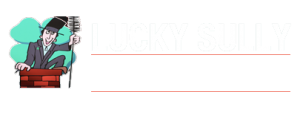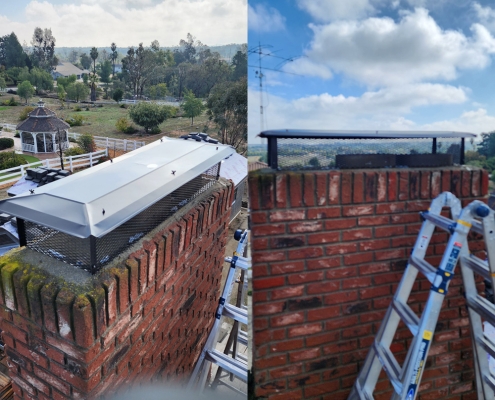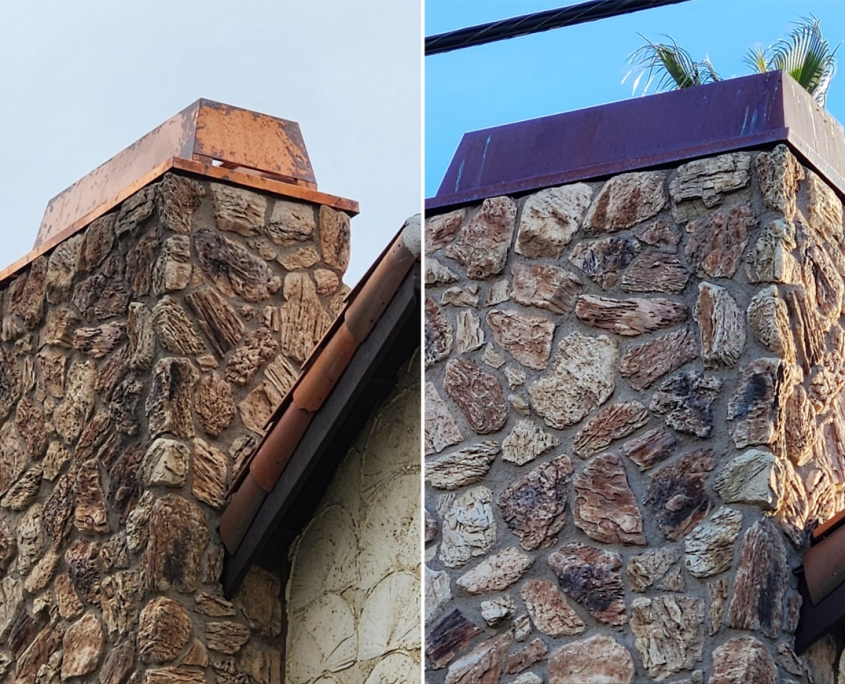5 Aesthetic and Functional Benefits of Custom Copper Chimney Caps
When it comes to enhancing the performance and appearance of your chimney, custom copper chimney caps are an excellent choice. These caps offer both aesthetic and functional benefits, ensuring your chimney is well-protected while adding a touch of elegance to your home. Copper is not only durable but also timeless, and its ability to resist weathering and corrosion makes it one of the best materials for chimney caps.
At Lucky Sully Chimney Sweep, we understand the importance of both aesthetics and functionality when it comes to chimney maintenance. In this article, we’ll take a deeper look at the five key aesthetic and functional benefits of custom copper chimney caps and explain why they are a great investment for any homeowner.
Timeless Aesthetic Appeal
Copper has long been recognized for its beauty and timeless appeal. When you install a custom copper chimney cap, you immediately enhance the look of your home. The shiny, bright copper finish adds an elegant touch that complements both modern and traditional home designs. Over time, copper develops a unique patina—a greenish-blue tint that many homeowners find visually striking. This natural aging process gives the chimney cap a rustic and sophisticated look, perfect for those who appreciate the charm of aged materials.
What’s more, copper is versatile and blends seamlessly with various roofing materials, stonework, and brickwork. Whether you have a sleek, modern design or a historic, colonial-style home, a custom copper chimney cap will effortlessly elevate its visual appeal.
The aesthetic value of a custom copper chimney cap is something that lasts for years, making it a worthwhile investment. At Lucky Sully Chimney Sweep, we offer expert advice and installation services to help you achieve the perfect look for your home with our Chimney Caps & Repairs.
Unmatched Durability and Longevity
Copper is known for its incredible durability, which is one of the main reasons it’s a top choice for chimney caps. Unlike other materials that can deteriorate over time due to harsh weather conditions, copper naturally resists rust, corrosion, and tarnishing. Copper’s inherent resistance to corrosion ensures that your chimney cap will maintain its structural integrity for decades.
Custom copper chimney caps can withstand rain, snow, extreme temperatures, and even the salty air from coastal regions. This resilience makes them an excellent choice for homeowners who want to invest in a long-lasting solution. While other materials might need frequent repairs or replacement, copper’s lifespan is much longer, saving you money on maintenance and replacements.
By investing in a custom copper chimney cap, you’re choosing a product that will protect your chimney and keep its performance intact for many years. With a minimal amount of maintenance, your copper chimney cap will continue to provide excellent protection against weather and debris. Lucky Sully Chimney Sweep can help ensure that your custom copper chimney cap is installed correctly, providing you with long-term durability and peace of mind.
Protection Against Water Damage
Water is one of the most significant threats to the integrity of a chimney. Without proper protection, rain and snow can seep into the chimney, causing rust, mold, and even structural damage to the liner and flue. This can lead to expensive repairs and reduced efficiency of your fireplace or heating system.
A custom copper chimney cap serves as a protective barrier that keeps water from entering your chimney. It works by covering the chimney opening, preventing rain, snow, and ice from getting inside while still allowing smoke and gases to escape. This crucial protection helps prevent rust and corrosion from damaging the internal components of the chimney system, extending the life of your chimney and fireplace.
Additionally, a chimney cap can help to prevent the accumulation of moisture inside your chimney, which can cause mold and mildew to grow. For homeowners who live in areas with frequent rain or snow, investing in a copper chimney cap is essential for maintaining the long-term health of the chimney. Learn more about how to prevent water damage with our Chimney Caps services.
Prevention of Animal Intrusions
Chimneys are a favorite entry point for many animals, including birds, squirrels, raccoons, and even bats. These creatures can build nests inside your chimney, obstruct airflow, and leave behind droppings, all of which create potential health hazards and serious blockages. If not addressed, animal intrusions can lead to a loss of chimney efficiency and, in some cases, dangerous situations such as fires.
A custom copper chimney cap helps to prevent animal intrusions by providing a secure barrier over the chimney opening. With a sturdy mesh screen, the cap keeps animals from entering while still allowing the chimney to function as needed. The mesh design also ensures that debris such as twigs and leaves don’t clog the flue, further improving airflow and reducing the chances of a chimney fire.
For homeowners in areas with heavy wildlife activity, a custom copper chimney cap offers peace of mind by preventing animals from causing damage or posing a threat to your chimney system. At Lucky Sully Chimney Sweep, we provide custom copper chimney caps that are designed to fit your specific chimney, ensuring maximum protection against unwanted intruders.
Enhancing Energy Efficiency
Proper airflow is essential for the efficient operation of your chimney and heating system. A custom copper chimney cap ensures that your chimney operates efficiently by preventing cold air from entering your home, which can lead to drafts and higher heating costs. During the winter months, the cap helps to keep the warm air inside your home, preventing it from escaping through the chimney.
By sealing the chimney properly, the custom copper cap reduces energy loss, making it easier to maintain a comfortable temperature throughout the year. This can translate into lower heating costs, especially in colder climates. Additionally, the cap can help to prevent backdrafts, which occur when cold air enters the chimney and forces smoke into your living space.
Investing in a custom copper chimney cap not only improves the aesthetic and functional value of your chimney but also contributes to the overall energy efficiency of your home. Whether you’re looking to save on heating costs or reduce your carbon footprint, a custom chimney cap is an investment that pays off in both comfort and savings.
Conclusion
Custom copper chimney caps offer a unique combination of beauty, durability, and practicality. From their stunning aesthetic appeal to their protective qualities against water damage and animal intrusions, copper chimney caps provide an all-around solution for homeowners who want to protect their chimneys and enhance the look of their homes. Their energy efficiency benefits are also an added bonus, making them an ideal choice for anyone looking to reduce heating costs and maintain a comfortable living environment.
At Lucky Sully Chimney Sweep, we specialize in the installation of custom copper chimney caps tailored to your home’s needs. Our experienced team ensures that your chimney cap is perfectly fitted, offering both aesthetic value and unmatched protection. If you’re interested in learning more about custom copper chimney caps, reach out to us today. We’ll help you make the best choice for your home’s chimney system with our Chimney Caps & Repairs services.
FAQs
What is the lifespan of a custom copper chimney cap?
Custom copper chimney caps are highly durable and can last for decades with minimal maintenance, thanks to copper’s natural resistance to rust and corrosion.
How does a copper chimney cap improve my home’s aesthetic?
Copper adds a touch of elegance and sophistication to any home. Its shiny finish is visually appealing, and over time, the natural patina gives it a unique, vintage look.
Do I need a chimney cap if I don’t use my fireplace often?
Yes, even if you don’t use your fireplace regularly, a chimney cap helps protect your chimney from the elements, prevents animals from nesting inside, and improves energy efficiency.
Can a copper chimney cap fit any chimney?
Yes, custom copper chimney caps are designed to fit your chimney perfectly, ensuring maximum protection and performance. Lucky Sully Chimney Sweep offers custom solutions tailored to your chimney’s specifications.
Will a copper chimney cap prevent rain from damaging my chimney?
Absolutely! A custom copper chimney cap is specifically designed to keep rain, snow, and ice from entering your chimney, preventing water damage and prolonging the life of your chimney system.








